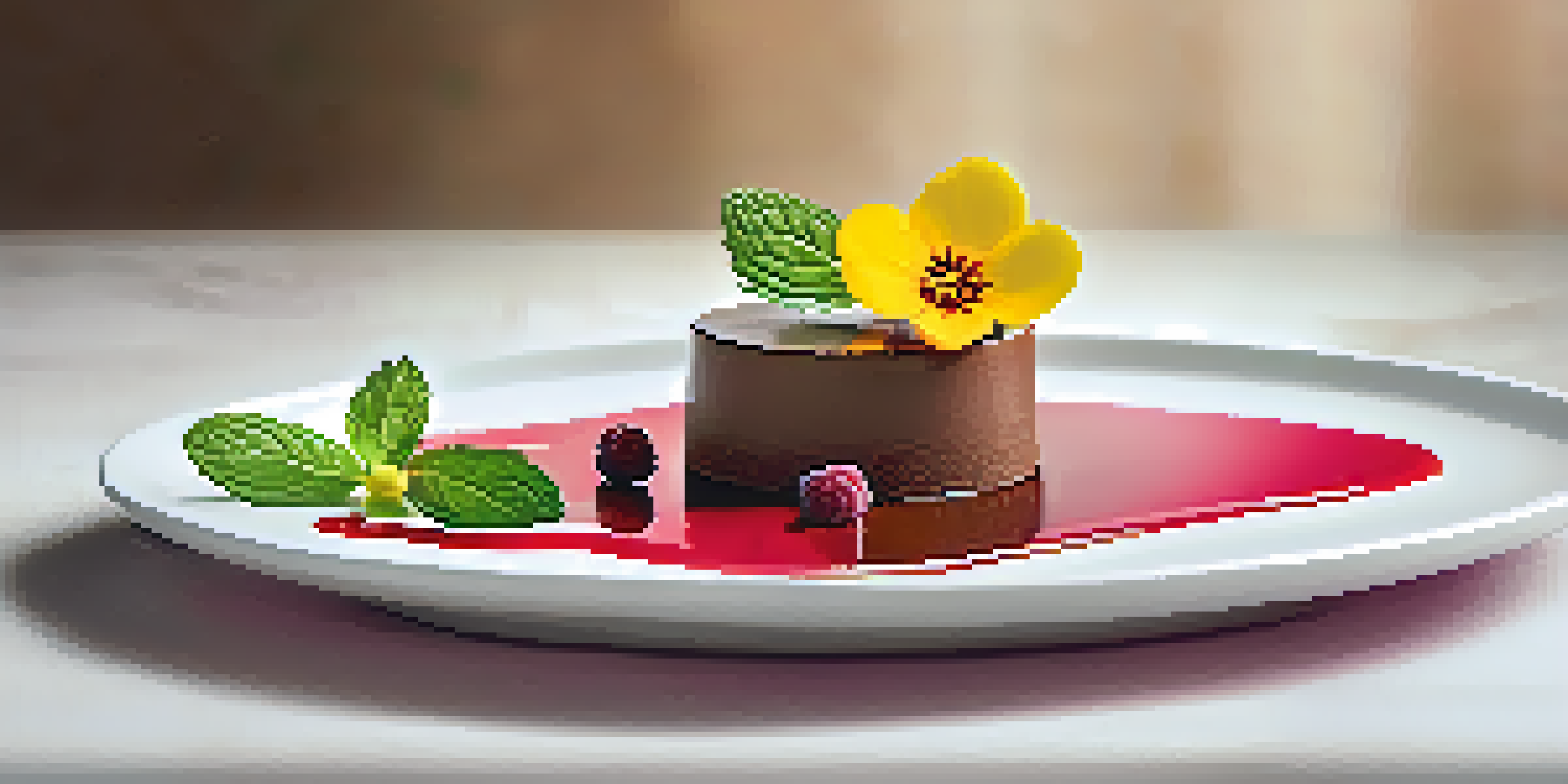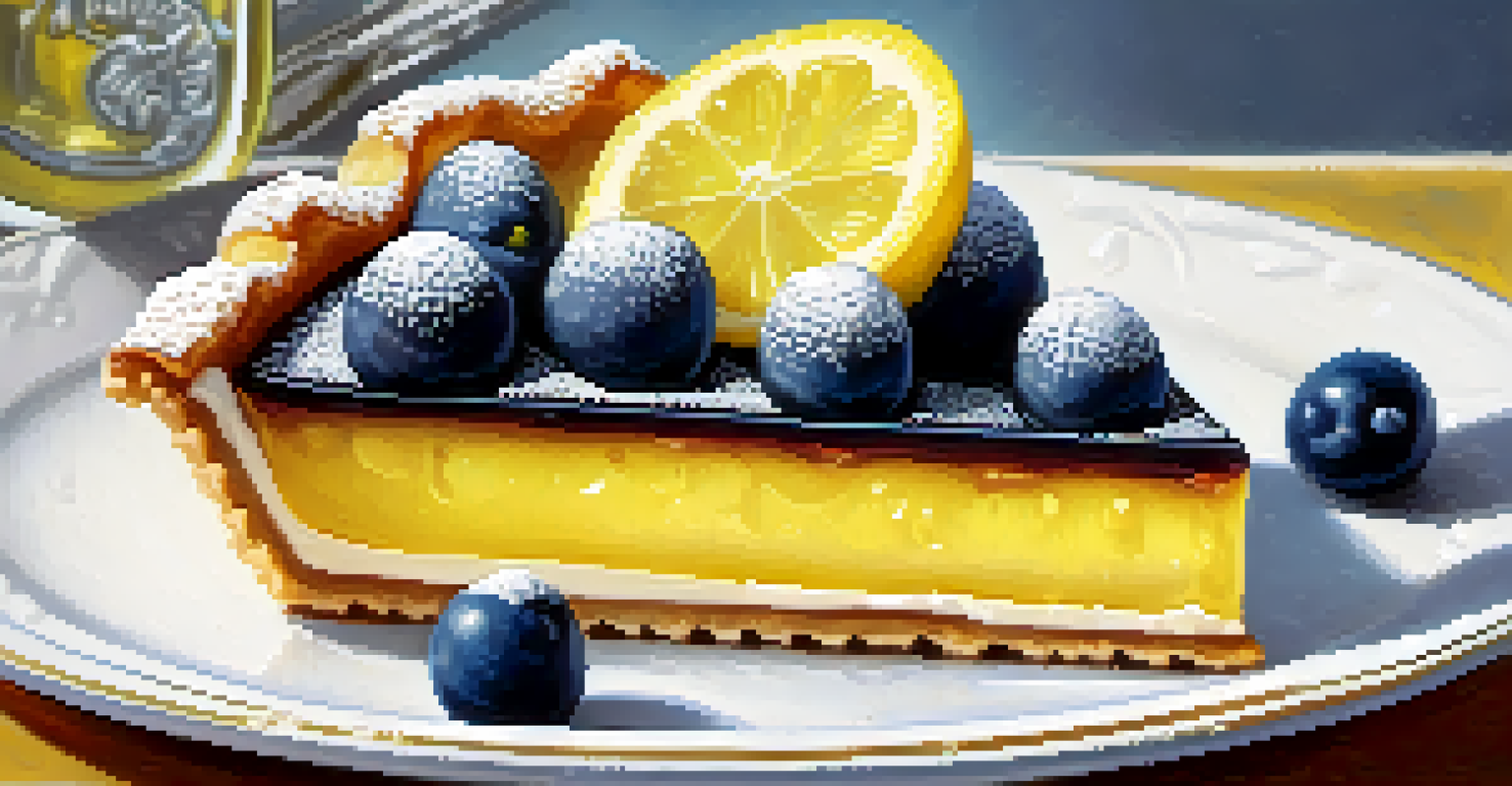The Art of Dessert: Elevating Sweet Courses in Fine Dining

Understanding the Role of Dessert in Fine Dining
Desserts serve as the grand finale in a fine dining experience, leaving a lasting impression on diners. They are not merely sweet treats; they encapsulate the creativity and skill of the chef. Just as a symphony needs its crescendo, a meal requires a dessert that resonates with the overall theme of the dining experience.
Dessert is like a feel-good song, and the best ones make you dance.
In fine dining, desserts often reflect the seasonality of ingredients and the chef's personal flair. They can evoke nostalgia or introduce adventurous flavors, leading diners on a culinary journey. This is why the dessert course can sometimes be the highlight of the meal, sparking joy and satisfaction.
Moreover, the presentation of dessert plays a crucial role in the dining experience. A beautifully plated dessert not only tantalizes the taste buds but also appeals to the eyes, creating an Instagram-worthy moment. This combination of taste and aesthetics is what sets fine dining desserts apart from everyday sweets.
The Evolution of Dessert Trends in Fine Dining
Dessert trends have evolved significantly over the years, influenced by culinary innovations and cultural shifts. From classic French pastries to contemporary deconstructed desserts, chefs are continuously pushing boundaries. This evolution invites diners to experience familiar flavors in exciting new forms.

For instance, the rise of plant-based dining has led to innovative desserts that use alternative ingredients without sacrificing flavor. Ingredients like aquafaba, derived from chickpeas, are now being used to create airy meringues and mousses. This trend not only caters to dietary needs but also encourages sustainability in the culinary world.
Desserts as Culinary Art
Desserts in fine dining are not just sweet treats; they are a reflection of the chef's creativity and skill, serving as the grand finale of the meal.
Additionally, the fusion of global flavors has created an intriguing dessert landscape in fine dining. Think matcha-infused tiramisu or mango sticky rice panna cotta. These combinations not only celebrate diverse culinary traditions but also challenge diners' palates, encouraging them to explore unfamiliar tastes.
The Importance of Seasonal Ingredients in Desserts
Seasonality plays a significant role in crafting exquisite desserts in fine dining. Using fresh, local ingredients ensures that the flavors are vibrant and authentic, which resonates with diners. When strawberries are in season, for example, a chef may create a luscious strawberry shortcake that showcases the fruit's natural sweetness.
A great dessert is like a great piece of art; it should be a feast for the eyes as well as the palate.
Moreover, seasonal ingredients often inspire creativity in dessert development. A chef might incorporate herbs or spices that are in season, elevating the dessert to new heights. For instance, a basil-infused sorbet during summer can surprise and delight diners with its refreshing taste and aromatic profile.
Incorporating seasonal ingredients also helps reduce the carbon footprint of a restaurant, as it minimizes the need for transportation. This commitment to sustainability not only appeals to eco-conscious diners but also enhances the restaurant's reputation as a responsible establishment.
Innovative Techniques in Fine Dining Desserts
Innovation is key in the art of dessert-making, with chefs constantly exploring new techniques to enhance their creations. Techniques such as sous vide, which involves vacuum-sealing ingredients and cooking them at precise temperatures, allow for exceptional flavor and texture combinations. This method can transform classic desserts into extraordinary experiences.
Another exciting technique is the use of molecular gastronomy, where science meets culinary art. Chefs can create edible spheres, foams, and gels that surprise diners with unexpected flavors and textures. For example, a chocolate sphere that melts under warm sauce reveals a hidden treasure of ice cream inside, making the dining experience memorable.
Seasonal Ingredients Matter
Incorporating seasonal ingredients into desserts enhances flavor, creativity, and sustainability, making each dish a truly authentic experience.
These innovative approaches invite diners to engage with desserts in a playful manner, transforming each bite into a mini adventure. Chefs who master these techniques not only showcase their skills but also enhance the overall dining experience, leaving guests eager for their next visit.
Pairing Desserts with Beverages for Enhanced Enjoyment
Pairing desserts with beverages can elevate the dining experience significantly. Just as wine complements savory dishes, the right beverage enhances the flavors of a dessert. A rich chocolate cake, for example, can be beautifully paired with a full-bodied red wine or a smooth espresso, creating a harmonious blend of flavors.
Chefs and sommeliers often work together to develop these pairings, considering elements like sweetness, acidity, and texture. A tart lemon tart, for instance, may shine when paired with a crisp, dry sparkling wine, balancing the dessert's acidity and enhancing its citrus notes. This attention to detail transforms a simple dessert into a sophisticated experience.
Furthermore, the trend of pairing desserts with craft cocktails or specialty coffees is gaining momentum. Imagine a spiced rum cocktail served alongside a warm bread pudding, where the flavors of both elements complement each other perfectly. These thoughtful pairings not only add depth to the dessert course but also invite diners to explore new flavor profiles.
The Role of Presentation in Dessert Courses
Presentation is an essential aspect of fine dining desserts, as it significantly impacts the overall experience. A beautifully plated dessert can evoke emotions and set expectations before the first bite is taken. The artful arrangement of elements on the plate creates a visual feast that engages diners and builds anticipation.
Chefs often use techniques like layering, garnishing, and contrasting colors to create stunning desserts. A vibrant raspberry coulis drizzled over a creamy panna cotta can make the dish pop, enticing diners to indulge. This focus on aesthetics not only pleases the eye but also reflects the chef's artistry and attention to detail.
Innovative Techniques Enhance Desserts
Chefs are utilizing innovative techniques, like molecular gastronomy and sous vide, to create unique and memorable dessert experiences.
Furthermore, creative presentation can spark conversation among diners, making the dessert course a memorable part of the meal. Sharing stories about the inspiration behind a dessert's design or the techniques used can create a deeper connection with the dish. This interactive experience encourages guests to savor each moment, enhancing their overall dining adventure.
Cultural Influences on Dessert Creation in Fine Dining
Cultural influences play a significant role in shaping dessert offerings in fine dining establishments. Chefs often draw inspiration from their heritage or travel experiences, creating unique dishes that reflect their backgrounds. This fusion of cultures allows diners to experience a world of flavors in a single meal.
For instance, a chef might blend traditional French pastry techniques with Japanese flavors, resulting in matcha éclairs or yuzu tarts. This kind of innovation not only showcases culinary skills but also invites diners to broaden their palates. The exploration of different cultures through dessert can be both educational and delightful.

Additionally, cultural influences can foster a sense of community and connection among diners. Sharing stories about the origins of a dessert or the chef's journey can enhance the overall experience, making it more memorable. This approach not only elevates the dessert course but also creates a deeper appreciation for the artistry behind each dish.